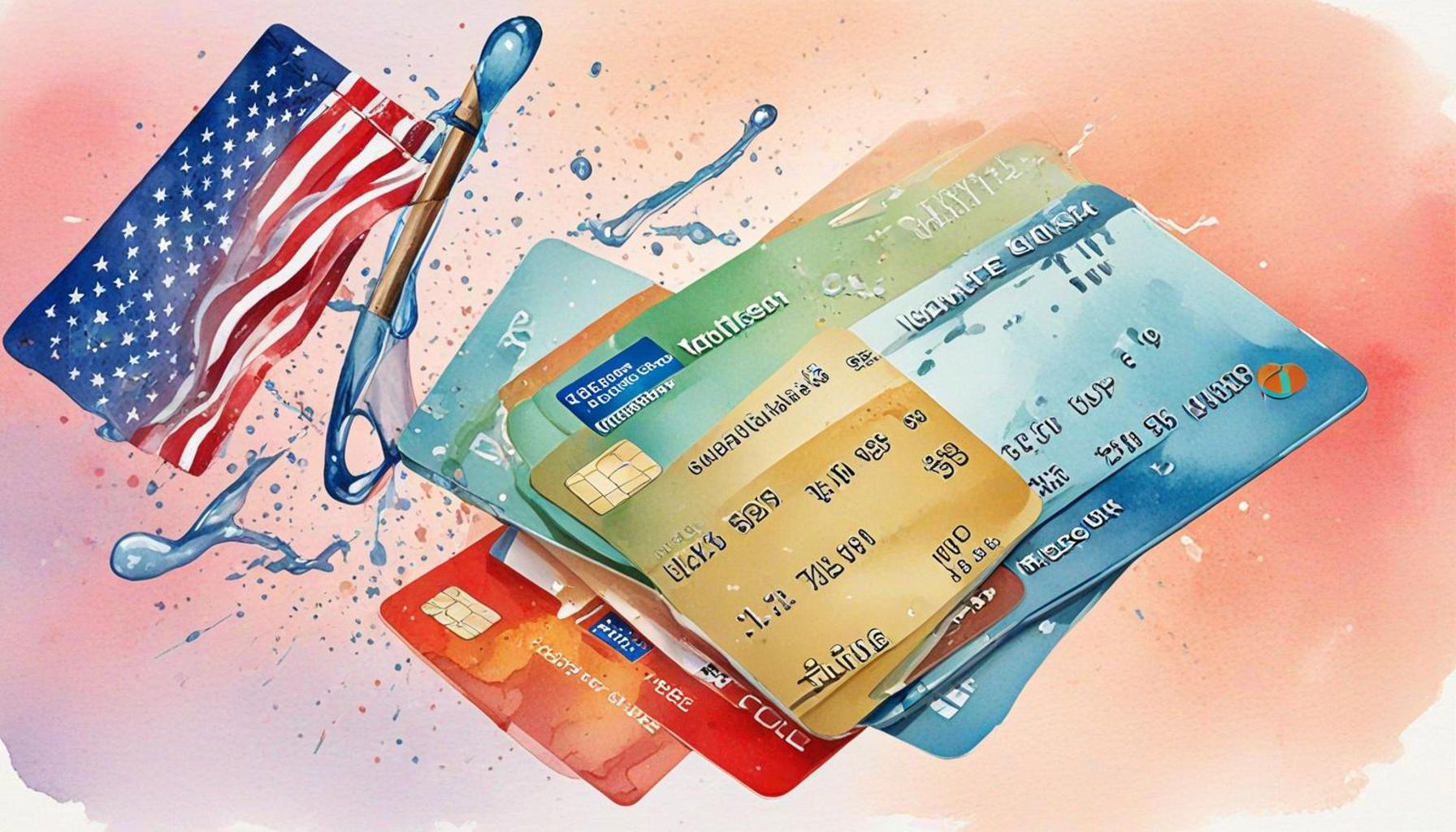Differences between secured and unsecured credit cards in the USA

Secured Credit Cards
Secured credit cards are designed for individuals seeking to build or rebuild their credit history. These cards require a cash deposit, which typically acts as both collateral and the credit limit. For example, if you deposit $500, your credit limit is often set at $500. This arrangement significantly reduces the risk for lenders, as they have a guarantee in the form of your deposit. Consequently, secured cards are particularly beneficial for those who are new to credit or have encountered financial difficulties in the past. Key features of secured credit cards include:
- Lower Risk for Lenders: The upfront deposit minimizes the likelihood of borrower default, making it easier for issuers to approve applications from individuals with insufficient or low credit scores.
- Credit Building: These cards enable users to improve or establish their credit scores over time by demonstrating responsible usage, such as making timely payments and keeping a low balance relative to the credit limit.
- Potential Fees: While many secured cards offer competitive terms, some may charge annual fees. It’s advisable to read the fine print to understand any associated costs before applying.
Unsecured Credit Cards
In contrast, unsecured credit cards do not require a collateral deposit, making them accessible for individuals with established credit histories. Approval for these cards is primarily based on the applicant’s creditworthiness and income level. Typically, unsecured cards feature several attractive characteristics, including:
- Higher Credit Limits: Unsecured credit cards often grant larger credit limits compared to their secured counterparts. For example, a cardholder might receive a limit of $2000 or more, depending on their credit score and financial history.
- Variety of Rewards: Many unsecured cards come with rewards programs, providing benefits such as cashback on purchases, travel points, or discounts at partner retailers, making them appealing for regular use.
- Risk of Debt: The ease of access to credit can lead to overspending, especially for individuals who may struggle with budgeting. It’s crucial for consumers to monitor their spending habits and make payments promptly to avoid accruing debt.
Making the Right Choice
Choosing between secured and unsecured credit cards is a significant decision that should align with one’s financial situation and goals. Individuals with low credit scores or those seeking to establish credit may find secured cards an excellent stepping stone. Conversely, those with good to excellent credit may lean towards unsecured cards due to their higher limits and additional perks.
Ultimately, understanding the distinct roles of secured and unsecured credit cards can empower consumers to make informed decisions that align with their overall financial strategies. Whether striving for credit rebuilding or aiming for rewards, each type serves a unique purpose in the management of personal finances.
CHECK OUT: Click here to explore more
Understanding Secured Credit Cards
Secured credit cards serve as a valuable tool for individuals aiming to build or repair their credit profiles. One of the defining features of secured cards is the requirement for a cash deposit, which not only acts as collateral but also determines the card’s credit limit. For instance, a deposit of $500 generally translates to a credit limit of $500. This structure significantly reduces the risk for credit card issuers, as the deposit serves as a form of security in the event of default. Such characteristics make secured credit cards particularly appealing for:
- Building Credit History: Users can enhance their credit scores over time by exhibiting responsible behavior, such as making on-time payments and maintaining low utilization rates. This gradual improvement in creditworthiness can eventually lead to the transition to unsecured credit options.
- Accessibility for Applicants with Limited Credit: Individuals who are new to credit or have faced financial setbacks can obtain these cards more easily than unsecured alternatives, as lenders are more willing to extend credit when there is a deposit involved.
- Potential for Improvement: After a period of responsible card use, many issuers offer the possibility to transition from a secured card to an unsecured card, marking a significant milestone in a consumer’s financial journey.
Exploring Unsecured Credit Cards
Unsecured credit cards, on the other hand, do not require any upfront cash deposits, which allows for a broader spectrum of applicants with established credit histories to gain access. The approval for unsecured cards is primarily contingent on an individual’s credit score and financial standing. These cards boast several noteworthy benefits, including:
- Increased Spending Power: Unsecured credit cards typically come with higher credit limits than secured cards, enabling cardholders to make larger purchases or manage their cash flow more effectively, with limits often starting from $2000 and going significantly higher based on creditworthiness.
- Rewards and Incentives: Many unsecured credit cards include attractive rewards programs, such as earning cashback on everyday purchases, accumulating travel points, or offering discounts at certain retailers. This makes unsecured cards more appealing for frequent users who want to maximize their spending efficiency.
- Potential for Overspending: While unsecured credit cards provide greater access to credit, they also pose a risk for overspending. This accessibility may lead users to accrue debt if they’re unable to manage their finances carefully or if they do not keep track of their spending patterns.
In summary, secured and unsecured credit cards each serve a distinct purpose depending on an individual’s financial situation and goals. Understanding the nuances of both types allows consumers to make astute decisions regarding their credit options. Whether the goal is to establish a solid credit foundation or to enjoy the benefits of a rewards program, recognizing the differences between these cards is essential for effective financial management.
SEE ALSO: Click here to read another article
Key Differences in Features and Regulations
While both secured and unsecured credit cards serve the fundamental purpose of facilitating credit transactions, the differences in their features and regulations highlight their unique roles in personal finance management. Understanding these distinctions can further empower consumers to choose the card that best aligns with their financial goals.
Credit Score Requirements
A significant differentiator between secured and unsecured credit cards lies in the credit score requirements to qualify for each. Secured credit cards are generally accessible to individuals with low or no credit scores, as the risk is mitigated by the required cash deposit. In contrast, unsecured credit cards often impose stricter credit score thresholds, typically ranging from 580 to 700 or higher, making them unattainable for many consumers with poor credit histories.
Fees and Interest Rates
Another crucial aspect to consider is the associated fees and interest rates. Secured credit cards frequently come with lower annual fees than unsecured cards due to the reduced risk for lenders. However, various issuers might charge application fees or other costs that could offset the initial savings. Conversely, unsecured credit cards may boast higher annual fees, especially those tied to premium rewards or benefits, and can also impose varying interest rates based on the applicant’s creditworthiness. According to a 2023 report from CreditCards.com, average interest rates for unsecured credit cards can be notably higher, ranging from 15% to 25%, depending on credit scores, while secured cards often have rates that can be more favorable.
Impact on Credit Utilization
Credit utilization, or the percentage of available credit being used, is an essential factor influencing credit scores. Both secured and unsecured cards affect credit utilization; however, their impact can differ due to credit limits. Secured credit cards, which have lower credit limits resulting from the initial deposit, can lead to higher utilization rates if users frequently max out their cards. In contrast, the typically higher limits of unsecured cards allow for better utilization ratios, provided users manage their cards effectively. Maintaining a utilization ratio below 30% is recommended for optimal credit score management.
Account Management and Transition Opportunities
Account management features can also vary significantly between secured and unsecured cards. Many unsecured cards come with advanced tools that help users track expenses and manage payments effectively. In recent years, a growing number of unsecured cards have also begun offering features such as real-time notifications and mobile app access for enhanced user experience. In contrast, secured cards may lack some of these advanced management tools, although certain issuers are expanding their offerings to enhance user experience.
Furthermore, many secured credit cards offer regular assessments of a user’s credit behavior and eligibility for graduation to an unsecured card, transforming the secured experience into a stepping stone towards traditional credit options. This opportunity not only serves as a motivator for responsible card usage but can also pave the way for users to access better financial products in the future.
Rewards and Perks
As previously mentioned, unsecured credit cards usually offer various rewards and perks that are not typically found with secured options. Examples include cashback, travel rewards, and special discounts. In 2023, approximately 70% of unsecured credit card holders reported utilizing rewards programs to enhance their shopping experiences, demonstrating their appeal. Secured cards, while generally lacking these enticing benefits, can occasionally feature limited rewards programs, but users should not expect the same level of value as with their unsecured counterparts.
SEE ALSO: Click here to read another article
Conclusion
In summary, navigating the landscape of secured and unsecured credit cards requires a clear understanding of their fundamental differences. While secured credit cards provide an accessible path for individuals with limited or poor credit histories, allowing them to build or rebuild their credit scores, the inherent requirement of a cash deposit can be a barrier for some. On the other hand, unsecured credit cards offer the potential for greater credit limits and enticing rewards but often come with stricter qualification criteria, making them less accessible for those with uncertain creditworthiness.
Additionally, the differences in fees, interest rates, credit utilization impact, and account management features underline the importance of consumer awareness in choosing the right card. It is crucial for individuals to evaluate their personal financial situations, risk tolerance, and credit goals when deciding which option fits their needs better. The transition possibilities from secured to unsecured cards present an encouraging pathway for users who are aiming to enhance their financial opportunities and credit profiles.
Ultimately, understanding the nuances between secured and unsecured credit cards enables consumers to make informed decisions that align with their financial aspirations. With careful consideration, one can leverage these credit tools effectively to navigate personal finance successfully in the USA.

Beatriz Johnson is a seasoned financial analyst and writer with a passion for simplifying the complexities of economics and finance. With over a decade of experience in the industry, she specializes in topics like personal finance, investment strategies, and global economic trends. Through her work on Território Deficiente, Beatriz empowers readers to make informed financial decisions and stay ahead in the ever-changing economic landscape.






